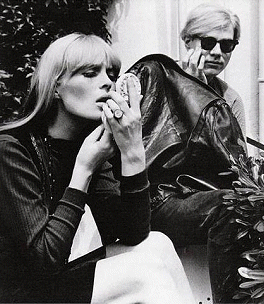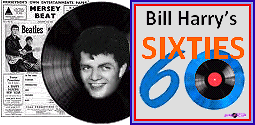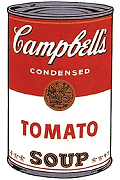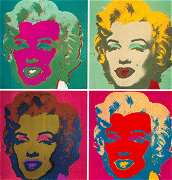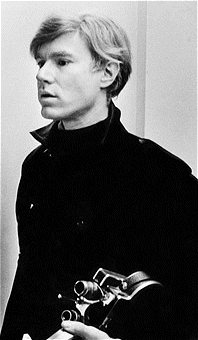In
1967, dreading a new round of public speaking, he sent Allen Midgette,
one of the actors in his films, on the circuit to pose as him with his
hair sprayed silver. Midgette would sit quietly on stage while Paul
Morrissey would speak on Warhol’s behalf. This ruse succeeded for four
months before it was exposed. In 1969 he told a magazine that he didn’t
do any art anymore, that all his new soup cans had been painted for
him by Brigid Polk. This ruse nearly backfired as European collectors
began to take the statement seriously – so he had to admit that he’d
only been joking.
The innovative artist became involved in avant-garde film-making from
his base ‘the Factory’ in Manhatten, with a selection of artists who
became ‘underground’ stars – Edie Sedgwick, Joe D’Alessandro, Viva,
Ingrid Superstar, Holly Woodlawn and Sylvia Miles. His many films included
‘Kiss’ (1963), a close-up of couples kissing; ‘Eat’ (1963) a 45-minute
film depicting pop artist Robert Indiana eating a mushroom; ‘Haircut’
(1963) a 33-minute film of a youth having his hair cut; ‘Shoulder’ (1964)
a close-up of dancer Lucinda Child’s shoulder, which lasted four minutes
and ‘Face’ (1965) an hour-long film close-up of Edie Sedgwick’s features.
Among his other numerous movies were: ‘Kitchen’ (1965); ‘Empire’ (1965);
‘My Hustler’ (1965); ‘Chelsea Girls’ (1966); ‘Blue Movie’ (1960) and
‘Women in Revolt’ (1972). After 1968, apart from ‘Women In Revolt’,
the films were directed by Paul Morrissey while Andy remained as producer.
The movies became more commercial and included ‘Flesh’ (1968); ‘Trash’
(1970) and ‘Heat’ (1974). |
|
